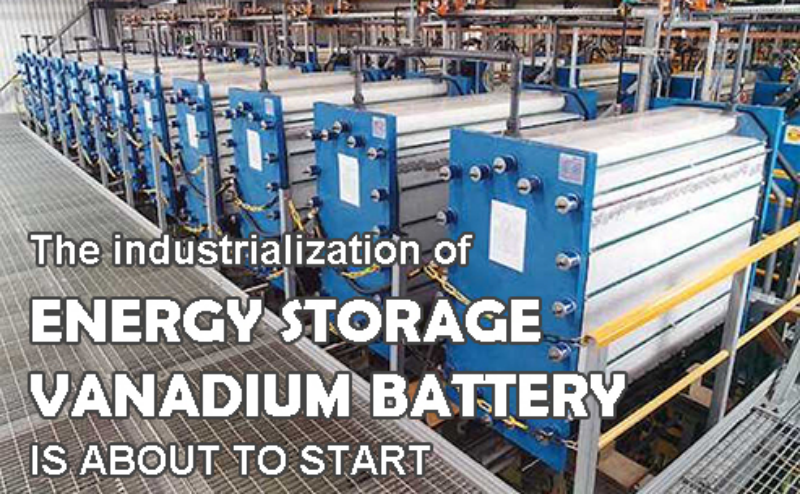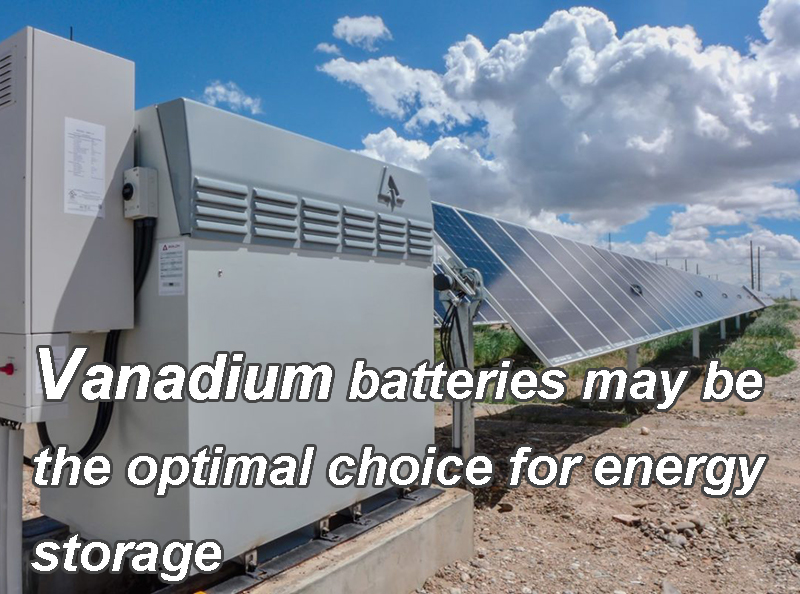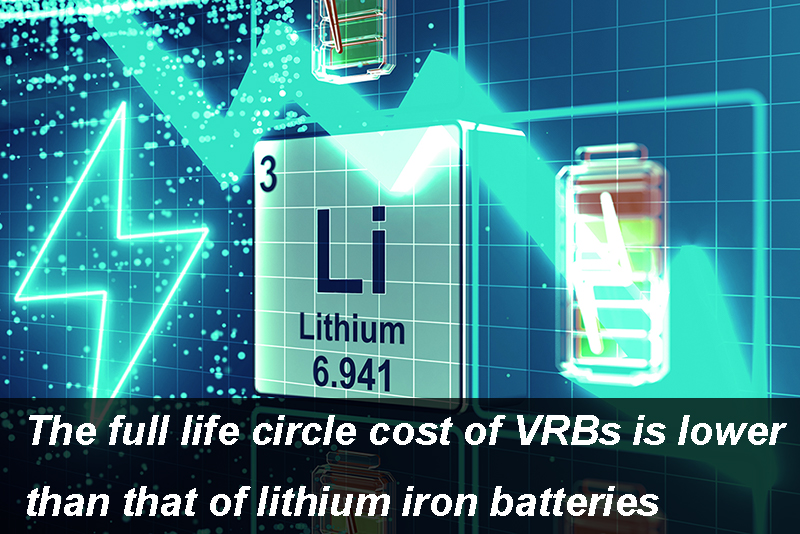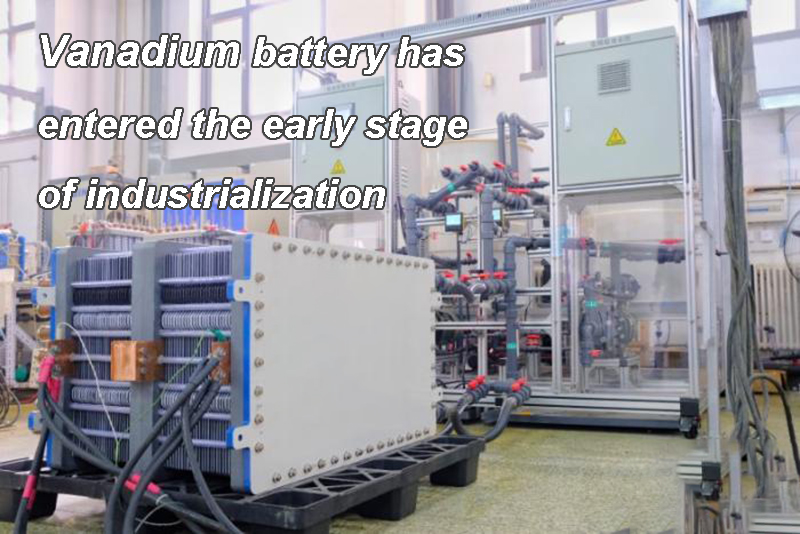
Main content:
As a large-scale energy storage(including home energy storage) system with high safety performance and long cycle life, vanadium batteries are currently in the early stage of large-scale industrialization in China. SHANGHAI ELECTRIC, which has been deeply engaged in liquid flow energy storage for more than 10 years, has reported nearly 10 100-megawatt projects in the vanadium battery industry in the past two years, which is the initial performance of the industrialization of vanadium battery energy storage.
According to the published data, by 2025, China's electrochemical energy storage is conservatively estimated to reach 30GW, and the market share of vanadium battery energy storage is conservatively estimated to reach 20%, with a total installed capacity of nearly 6GW. This is expected to bring about an explosion in demand for vanadium products and a revaluation of vanadium products by industry chain companies.
1.Vanadium batteries may be the optimal choice for energy storage
For safety reasons, the latest relevant documents issued by the Chinese government on June 29 require that medium and large-scale electrochemical energy storage power stations shall not use ternary lithium batteries and sodium-sulfur batteries (a type of sodium-ion battery). The main customer corresponding to energy storage is the grid side, and safety is the bottom line of energy storage. One of the characteristics of vanadium batteries is outstanding safety performance. The full name of vanadium battery is all-vanadium redox flow battery.

The biggest feature of the flow battery is that it uses an aqueous electrolyte without the risk of combustion and explosion. The lithium battery uses a highly flammable organic electrolyte, which can only reduce the risk probability but cannot be avoided absolutely. Although the energy density of sodium-sulfur batteries is better than that of flow batteries, the batteries are only separated by brittle ceramic separators, which will explode once the separator is damaged. The advantages of vanadium batteries do not stop there. In theory, they can be charged and discharged indefinitely.
Thanks to the separation of the flow battery electrolyte and the stack, the electrolyte will not be lost and consumed during the operation of the battery, and infinite cycles can be achieved from the perspective of life. From the perspective of the design of stacks and auxiliary systems, the current designed cycle life of vanadium batteries is greater than 15,000 times, much higher than 800 times for ternary lithium batteries and 3,000-6,000 times for lithium iron phosphate. According to two charges and two discharges a day, the vanadium battery project can be guaranteed to have a 20-year life cycle.
In addition, vanadium batteries are also ahead of lithium batteries in terms of resource security. Compared with lithium resources, which account for only 7% of China's resource reserves, China's vanadium resources and vanadium ore reserves are ranked first in the world, accounting for 39% and 68%, respectively. And the vanadium in the vanadium battery will not be consumed and can be recycled without causing a bottleneck of resource shortage. On the whole, vanadium redox flow batteries are more suitable for large-scale energy storage than lithium iron phosphate due to the advantages of high safety, long energy storage time, long life, and no pollution.
2.The full life circle cost of VRBs is lower than that of lithium iron batteries

From the perspective of initial investment cost, vanadium batteries are higher than lithium batteries and pumped hydro storage. According to relevant information, the investment cost per kilowatt of vanadium battery is between 4500~6000 RMB, while the cost per kilowatt of pumped storage and lithium battery is between 750~1200 RMB and 2500~4500 RMB respectively. The stack and electrolyte are the main components of the cost of vanadium batteries, accounting for 37% and 41% of the total cost, respectively. Among them, the cost of the stack mainly comes from materials such as separators.
With the advancement of technology, the weldable porous ion-conducting membrane currently developed by DALIAN INSTITUTE OF CHEMICAL PHYSICS can reduce the use area of the stack membrane by 30%, and the total cost can be reduced by 40%. The main cost of the electrolyte is vanadium, which is a relatively scarce metal and has a high price. Data shows that on July 27, 2022, China's homebred vanadium price was 1.9 million RMB/ton, much higher than lithium carbonate's 470,500 RMB/ton. Therefore, the main cost reduction path for vanadium electrolyte is through recycling. It is understood that the electrolyte of vanadium batteries is easy to recycle, and almost 100% of the residual value can be recycled and reused.
From the perspective of investment in the full life circle, the investment cost of vanadium batteries is lower than that of lithium iron batteries. "In a 5-year or 20-year cycle, the electrolyte of vanadium batteries will not be worn out and consumed, and there is no cost of follow-up additional investment, but iron-lithium batteries require additional investment in the medium term." SHANGHAI ELECTRIC said. The chairman of Zhiguang also said that the investment in the life cycle includes initial investment cost, operation and maintenance cost, decommissioning treatment cost and power loss cost. This needs to be controlled throughout the life cycle, and a system with a low initial cost may have a higher life cycle cost.
3.Vanadium battery has entered the early stage of industrialization

From the technical point of view, the current technological maturity of vanadium batteries has reached the standard of commercial application; from the industrial point of view, flow batteries have the strongest match with the demand for large-scale energy storage, and have entered the early stage of industrialization. With the imminent release of vanadium batteries, the upstream material side has received extensive attention from the market. In terms of precursors, Pangang said that vanadium and titanium are its key development businesses. Pangang is the largest vanadium product manufacturer in China. Its controlling shareholder, Pangang Group, owns two mining areas, Baima and Panzhihua. The reserves of vanadium-titanium magnetite are about 1.304 billion tons, and the recoverable amount is about 613 million tons.
In terms of production capacity, the company has the world's largest production capacity of vanadium products, equivalent to 40,000 tons of vanadium pentoxide per year. In 2021, the market share of the company's vanadium products in China will be as high as 68.14%, ranking first in the industry. At the same time, Pangang's industrial chain continues to deepen downstream. In July 2022, Pangang signed a cooperation agreement with RONGKE POWER, the world's leading vanadium battery energy storage system service provider. The two parties will jointly invest in the construction of a vanadium electrolyte factory, and initially build a vanadium electrolyte production line demonstration project with an annual output of 2,000 cubic meters in Panzhihua, Sichuan.

HBIS is also one of the major manufacturers of vanadium battery raw materials. The company has a production capacity of 22,000 tons/year of vanadium products, with world-leading production technology and low cost, and has the capacity to mass-produce vanadium battery electrolytes. In July 2022, HBIS stated that it has built a 1,000-ton/year high-purity vanadium production line and a 1,000-ton/year vanadium electrolyte production line. The quality of its products has been certified by top vanadium battery manufacturers in China and abroad, and it is used in some photovoltaic-vanadium energy storage systems. HBIS is currently planning to build a 50,000 cubic meter/year electrolyte production line and a 300MW/year vanadium battery equipment production line in three phases from 2022 to 2025.
In terms of vanadium batteries, SHANGHAI ELECTRIC, one of the Top 10 vanadium battery companies in China, has established a liquid flow energy storage team since 2011, mainly responsible for the research and development and production of battery cells. At present, it has successfully implemented more than 50 kilowatt and megawatt-level flow battery energy storage projects, and the reserve of flow battery energy storage orders in hand is nearly 3GWh. While cultivating the stack, SHANGHAI ELECTRIC is also actively deploying upstream resources. In 2021, the company formed a cooperation with Australia's Vecco Group on the construction of a vanadium electrolyte plant in Queensland, northeastern Australia, and signed a 10MWh vanadium electrolyte buyout agreement with it.
Related article: AGM vs flooded battery, Top 10 lithium battery companies